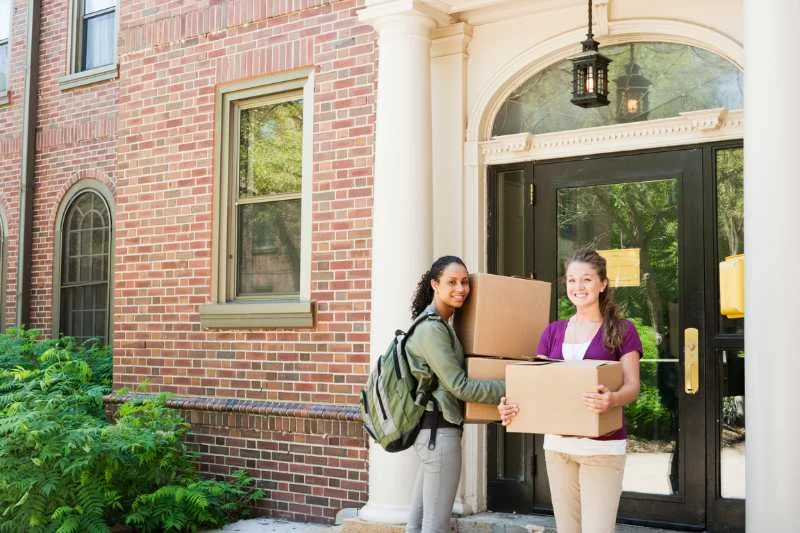Key takeaways
- Learning how to improve student housing security is essential for protecting residents while also supporting academic success, well-being, and community trust.
- Strong security measures directly impact occupancy and retention by attracting new students and encouraging lease renewals.
- Compliance with safety regulations, including those tied to Section 8 housing, reduces liability risks and protects funding opportunities.
- Modern solutions like cloud-based access control, visitor management tools, and surveillance cameras offer scalable protection tailored to student housing needs.
- Investing in integrated systems ensures both safety and convenience while preventing inefficiencies caused by multiple disconnected platforms.

Student housing security has become a growing concern as college enrollment continues to rise and campuses welcome increasingly diverse populations. Parents and students expect modern student housing to prioritize safety just as much as comfort and convenience.
This guide explores how to improve student housing security with practical strategies that schools, property managers, and housing providers can implement. From technology-driven access control to community-based initiatives, we’ll cover ways to improve security on college campuses and in private student residences to create safer, more supportive living environments.
In this post:
- What is student housing security?
- Why improving student housing security matters
- Common risks and challenges in student housing
- 7 ways to improve student housing security
- Evaluating the cost vs. benefit of security upgrades
- How to choose the right student housing security solutions
- Student housing security FAQs
What is student housing security?
Student housing security refers to the policies, technologies, and practices put in place to keep residents safe in both on-campus and off-campus housing. It includes everything from access control at building entrances to surveillance systems, emergency preparedness, and community awareness programs.
At its core, designs for student housing security aim to prevent theft or unauthorized entry and create a stable environment where students can live, study, and thrive without safety concerns overshadowing their experience.
Differences in housing types
- Traditional campus dorms. The college or university manages these and usually benefits from direct campus police presence, strict visitor rules, and institutional safety standards. However, because dorms often house hundreds of students in close quarters, risks such as theft, unauthorized visitors, and overcrowding are common.
- Off-campus apartments. The school may not own these properties, but they still attract large student populations. While they often have fewer institutional safety requirements, they provide more independence for students. Security here typically relies on property managers or third-party providers to implement systems like controlled access, surveillance, or patrols.
- Private student housing communities. Built specifically for students, these communities combine elements of both dorm life and off-campus living. They often advertise upgraded amenities and are expected by parents and students to offer modern security features, such as smart access control and on-site staff trained in resident safety.
Why improving student housing security matters
Creating a safe environment is one of the most important responsibilities in the student housing sector, and security directly affects the daily lives of residents and the success of the property itself. Below are the key reasons why improving student housing security should be a top priority for schools, administrators, and property managers.
Key reasons:
- Safety as the top priority
- Impact on occupancy and retention
- Compliance requirement
- Financial consequences of poor security
Safety as the top priority
Security is the foundation of trust in student housing. Parents want reassurance that their children are living in a safe environment, while students need to feel comfortable enough to focus on academics and social development. Administrators and property managers who prioritize safety not only reduce risks but also create an atmosphere where residents can thrive. A secure environment contributes directly to student well-being, fostering a sense of stability that supports both mental health and academic success.
Impact on occupancy and retention
Security measures play a measurable role in attracting and retaining residents. Student housing properties that advertise features such as controlled access, on-site staff, and surveillance technology stand out in a competitive market. These features not only draw new students but also make current residents more likely to renew their leases, leading to higher occupancy rates. Conversely, properties with frequent incidents or a poor safety reputation may struggle with vacancy, which directly affects revenue and long-term viability.
Compliance requirements
Many housing providers are required to meet local and federal safety regulations, particularly those that serve Section 8 housing students or receive government funding. These compliance standards often cover fire safety, building access, emergency preparedness, and surveillance. Falling short of these requirements can result in fines, loss of funding, or restrictions on future housing programs. Staying compliant ensures both the safety of residents and the financial stability of the property.
Financial consequences of poor security
Beyond compliance, poor security has significant financial repercussions. Properties that fail to address risks may face liability claims if residents or visitors are harmed due to negligence. Negative publicity from safety incidents can also damage reputation and make it difficult to market units to incoming students. High turnover rates caused by safety concerns increase operational costs, as units must be re-released more frequently. In contrast, investing in robust security measures protects property value, minimizes risk exposure, and establishes a positive reputation that drives consistent revenue.
Common risks and challenges in student housing
Student housing security presents unique challenges compared to conventional multifamily or residential properties. Student populations are highly transient, with residents changing every semester or academic year, which complicates long-term security planning.
Many residents are also living away from home for the first time, which means they may be less aware of safety protocols or more prone to risky behavior, such as propping doors open or sharing access credentials.
Additionally, balancing the need for an open, social environment with the responsibility of maintaining a secure property creates tension that property managers and schools must navigate carefully.
7 ways to improve student housing security
- Modern access control systems
- Visitor management systems
- Security cameras
- Package management solutions
- Staff training and resident awareness
- Lighting and environmental design
- Emergency preparedness and integrations
1. Modern access control systems
Outdated locks and keys present serious risks in student housing because keys can easily be lost, copied, or shared. This lack of accountability makes it difficult to track who has access to the property at any given time.
Cloud-based access control provides a much safer alternative. With features like remote management, customizable permissions, and mobile credentials, property managers can ensure only authorized individuals enter the building. These systems also make it easier to adjust access rights when students move in or out, which is a common occurrence in the student housing sector.
Examples of modern solutions include video intercoms for student housing, keypad entry systems, and visitor management tools that connect with smartphones. Together, these upgrades provide convenience while significantly improving security.
2. Visitor management systems
Unauthorized visitors are one of the biggest security challenges in student housing. Visitor management systems help prevent strangers from entering the property unchecked.
Tools like video intercoms, QR code-based intercoms, and temporary visitor passes make it simple to verify guests while still keeping the process convenient for students. In addition, creating a digital log of visitor activity provides accountability and evidence if an incident occurs.
3. Security cameras
Strategically placed security cameras are essential for both deterrence and investigation. Indoor cameras should cover lobbies, hallways, and common areas, while outdoor cameras are best for entryways, parking garages, and walkways.
Pairing cameras with access control events allows property managers to quickly review footage tied to a specific entry or user. This combination strengthens security while streamlining incident response. Cameras not only deter crime but also provide clear evidence when problems arise.
4. Package management solutions
Students are among the highest recipients of online deliveries, which makes package security a growing concern. Leaving parcels unattended in lobbies or communal spaces creates opportunities for theft.
Secure package rooms or lockers protect deliveries while offering convenience to residents who can pick up items on their own schedule. Adding this amenity reduces theft risk and increases resident satisfaction at the same time.
5. Staff training and resident awareness
Technology alone cannot solve every security challenge. Well-trained staff are critical to responding effectively to emergencies, enforcing access policies, and handling security breaches.
Educating residents is equally important. Students should be reminded not to prop open doors, to report suspicious activity, and to respect community-wide safety practices. Creating a culture of awareness encourages buy-in from everyone and makes the property safer overall.
6. Lighting and environmental design
Poorly lit pathways, parking areas, and entrances increase the risk of crime by giving potential intruders places to hide. Proper lighting throughout the property is one of the most cost-effective ways to improve security.
Landscaping also plays a role. Overgrown shrubs or poorly placed trees can create hiding spots that compromise visibility. Designing outdoor spaces with clear sightlines, open walkways, and minimal blind spots reduces opportunities for crime.
7. Emergency preparedness and integrations
Being prepared for emergencies is a key part of student housing security. Alarm systems, emergency communication tools, and integration with local law enforcement allow properties to respond quickly when incidents occur.
System-wide alerts and mobile notifications keep residents informed during emergencies and help maintain order. These integrations strengthen both safety and communication across the property.
Evaluating the cost vs. benefit of security upgrades
Investing in security may seem costly upfront, but the long-term savings often outweigh initial expenses. Strong security systems reduce liability, increase resident retention, and may even lower the need for additional security staff.
What’s more, another student housing trend to keep in mind is how balancing technology with physical measures ensures comprehensive protection. While advanced tools like cloud-based access control and surveillance are effective, basic measures like lighting and staff training remain important.
For properties with budget constraints, phased upgrades can provide a practical approach. Prioritizing high-impact solutions first allows housing providers to gradually enhance security while managing costs responsibly.
How to choose the right student housing security solutions
Selecting the right security solutions for student housing requires careful planning. Property managers should focus on systems that not only address current needs but also prepare the property for long-term success.
Asking the right questions during the evaluation process can make all the difference:
- Does it integrate with existing systems? Security solutions should work seamlessly with access control, cameras, visitor management, and communication tools already in place. Integrations reduce complexity, prevent gaps in protection, and create a more unified experience for residents and staff.
- Is it easy for staff and residents to use? The most advanced technology will fail if it is too complicated. User-friendly platforms encourage adoption, reduce training time, and make it simple for students to follow safety procedures. Systems should be intuitive and mobile-friendly to align with how students and staff interact daily.
- Can it scale with future growth or renovations? Student housing often undergoes expansions, renovations, or turnover in residents. Security solutions need to adapt to these changes without requiring a complete overhaul. Scalable systems allow properties to add new doors, buildings, or features as the community grows.
- Does it improve both safety and convenience? The best systems strike a balance between protection and usability. Security should never feel restrictive or disruptive to daily life. Solutions that allow mobile access, self-service visitor management, and quick emergency communication improve safety while making life easier for residents.
Student housing security FAQs
- How can we improve the on-campus housing experience?
- What is the best way to ensure students’ safety, security, and well-being?
How can we improve the on-campus housing experience?
The best way to improve on-campus housing is by creating a safe, convenient, and welcoming environment. Security upgrades such as modern access control, surveillance cameras, and package management systems help build trust. Pairing these with smart amenities and strong resident engagement creates a community where students feel both protected and supported.
What is the best way to ensure students’ safety, security, and well-being?
Ensuring student safety requires a combination of technology and community-focused engagement. Tools like access control systems, security cameras, and secure package rooms provide the foundation for protection. At the same time, resident education, staff training, and emergency preparedness programs strengthen awareness and create a culture of shared responsibility for safety.






